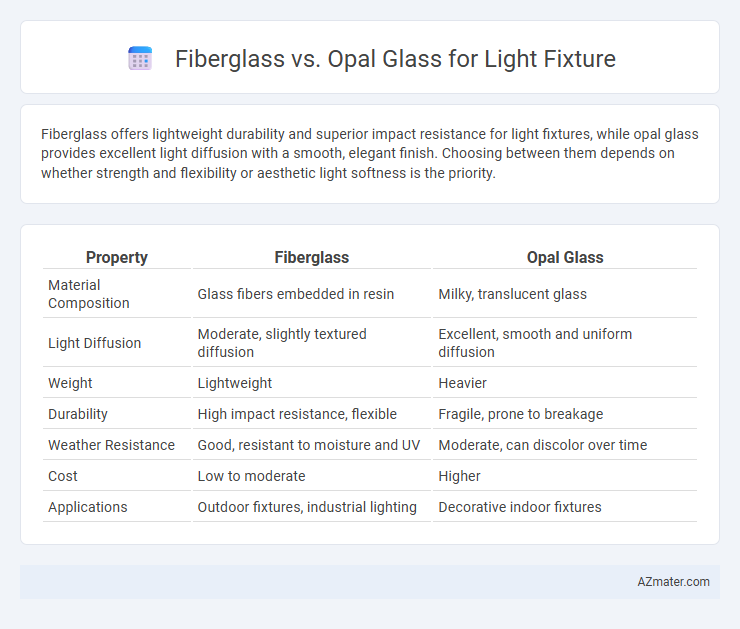Fiberglass offers lightweight durability and superior impact resistance for light fixtures, while opal glass provides excellent light diffusion with a smooth, elegant finish. Choosing between them depends on whether strength and flexibility or aesthetic light softness is the priority.
Table of Comparison
| Property | Fiberglass | Opal Glass |
|---|---|---|
| Material Composition | Glass fibers embedded in resin | Milky, translucent glass |
| Light Diffusion | Moderate, slightly textured diffusion | Excellent, smooth and uniform diffusion |
| Weight | Lightweight | Heavier |
| Durability | High impact resistance, flexible | Fragile, prone to breakage |
| Weather Resistance | Good, resistant to moisture and UV | Moderate, can discolor over time |
| Cost | Low to moderate | Higher |
| Applications | Outdoor fixtures, industrial lighting | Decorative indoor fixtures |
Introduction to Fibre Glass and Opal Glass in Lighting
Fibre glass in lighting offers high durability, excellent thermal resistance, and lightweight properties, making it ideal for industrial and outdoor light fixtures. Opal glass provides a smooth, diffused light effect with high translucency that reduces glare and enhances aesthetic appeal in residential and commercial lighting. Both materials serve distinct functional and design roles, with fibre glass excelling in robustness and opal glass prioritizing soft, uniform illumination.
Composition and Manufacturing Differences
Fiberglass light fixtures are composed of woven glass fibers embedded in a resin matrix, providing high tensile strength and flexibility due to their composite nature. Opal glass, made from silica combined with various metal oxides such as potassium oxide, undergoes a glass melting and annealing process, resulting in a smooth, uniformly diffused translucent surface. Manufacturing fiberglass involves a curing process where resin hardens around the fibers, while opal glass manufacturing requires precise melting and controlled cooling to achieve its characteristic translucency and opacity.
Light Diffusion Capabilities
Fibre glass light fixtures offer moderate light diffusion with a slightly textured surface that scatters light unevenly, resulting in some hotspots. Opal glass provides superior light diffusion due to its smooth, milky-white finish, which evenly disperses light to minimize glare and create a soft, uniform illumination. The enhanced translucency of opal glass makes it an ideal choice for applications requiring consistent and diffused lighting.
Durability and Longevity
Fibre glass light fixtures offer superior durability due to their resistance to impact, corrosion, and extreme weather conditions, making them ideal for long-term outdoor use. Opal glass fixtures provide excellent longevity in indoor environments by maintaining their aesthetic clarity and resisting yellowing over time, but they are more prone to breakage compared to fibre glass. For applications requiring robust, long-lasting performance with minimal maintenance, fibre glass is generally the preferred choice.
Aesthetic Appeal and Design Flexibility
Fibre glass offers a lightweight and durable option for light fixtures with a textured, translucent finish that enhances modern and industrial aesthetics. Opal glass provides a smooth, elegant surface with excellent light diffusion, creating a soft, uniform glow ideal for classic and contemporary designs. Designers favor fibre glass for its shape versatility and impactful textures, while opal glass excels in achieving refined, polished appearances with superior light quality.
Weight and Installation Considerations
Fibre glass light fixtures offer a lightweight alternative to opal glass, significantly reducing installation time and effort, especially where overhead mounting is required. Opal glass, while heavier, provides superior diffusion and a more uniform light distribution but may require additional support structures and careful handling during installation due to its fragility. Choosing fibre glass can minimize labor costs and increase safety during installation, whereas opal glass is preferred for aesthetic quality and durability in permanent fixtures.
Cost Comparison
Fibre glass light fixtures generally offer a lower upfront cost compared to Opal glass, making them a budget-friendly option for large-scale installations. Opal glass, while more expensive initially, provides superior durability and a premium aesthetic that can reduce long-term maintenance and replacement expenses. Choosing between fibre glass and opal glass depends on balancing immediate budget constraints against potential savings in longevity and overall fixture quality.
Environmental Impact and Sustainability
Fiberglass light fixtures are made from reinforced plastic, offering durability and lightweight properties but posing challenges in recycling due to non-biodegradable resins and chemical additives, which contribute to environmental pollution. Opal glass, composed primarily of silica and natural minerals, is highly recyclable and inert, resulting in a lower environmental footprint and reduced waste in landfills. Choosing opal glass enhances sustainability by supporting closed-loop recycling systems and minimizing volatile organic compound (VOC) emissions during production compared to fiberglass manufacturing.
Maintenance and Cleaning Requirements
Fiberglass light fixtures offer superior durability and resist moisture and dust buildup, making maintenance and cleaning easier with just a damp cloth. Opal glass, while providing excellent light diffusion and aesthetic appeal, requires more careful handling during cleaning to prevent scratches and often needs specialized glass cleaners. Fiberglass's non-porous surface reduces grime adherence, resulting in less frequent cleaning cycles compared to the more delicate and porous nature of opal glass.
Best Applications for Fibre Glass vs Opal Glass Fixtures
Fibre glass light fixtures excel in industrial and outdoor applications due to their high durability, resistance to moisture, and impact toughness, making them ideal for harsh environments like factories and marine settings. Opal glass fixtures offer superior diffusion and aesthetic appeal, making them the best choice for indoor residential and commercial spaces where uniform soft lighting is desired. Choosing fibre glass prioritizes robustness and longevity in demanding conditions, while opal glass enhances ambient lighting with its elegant translucency.

Infographic: Fibre glass vs Opal glass for Light fixture
 azmater.com
azmater.com